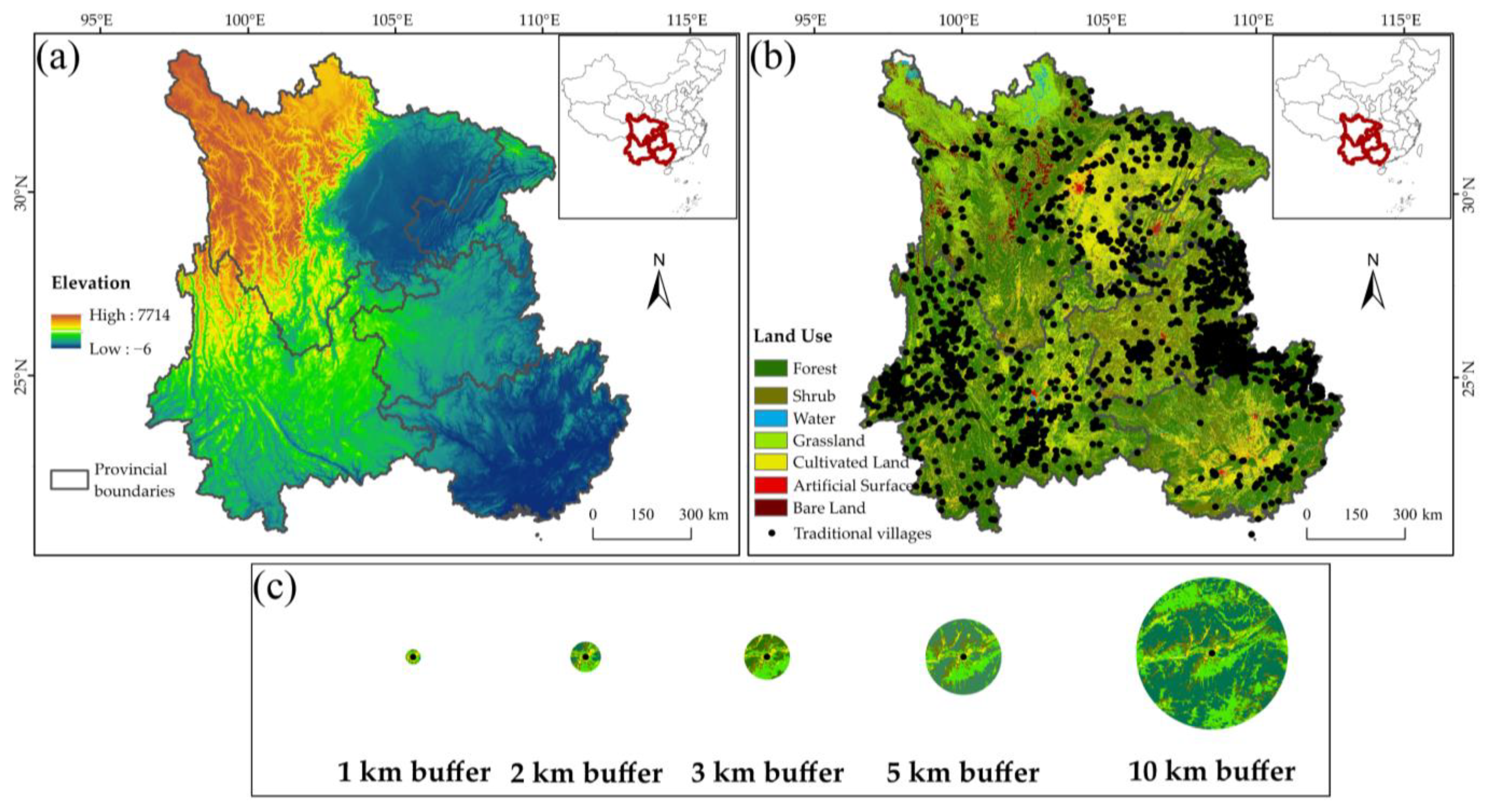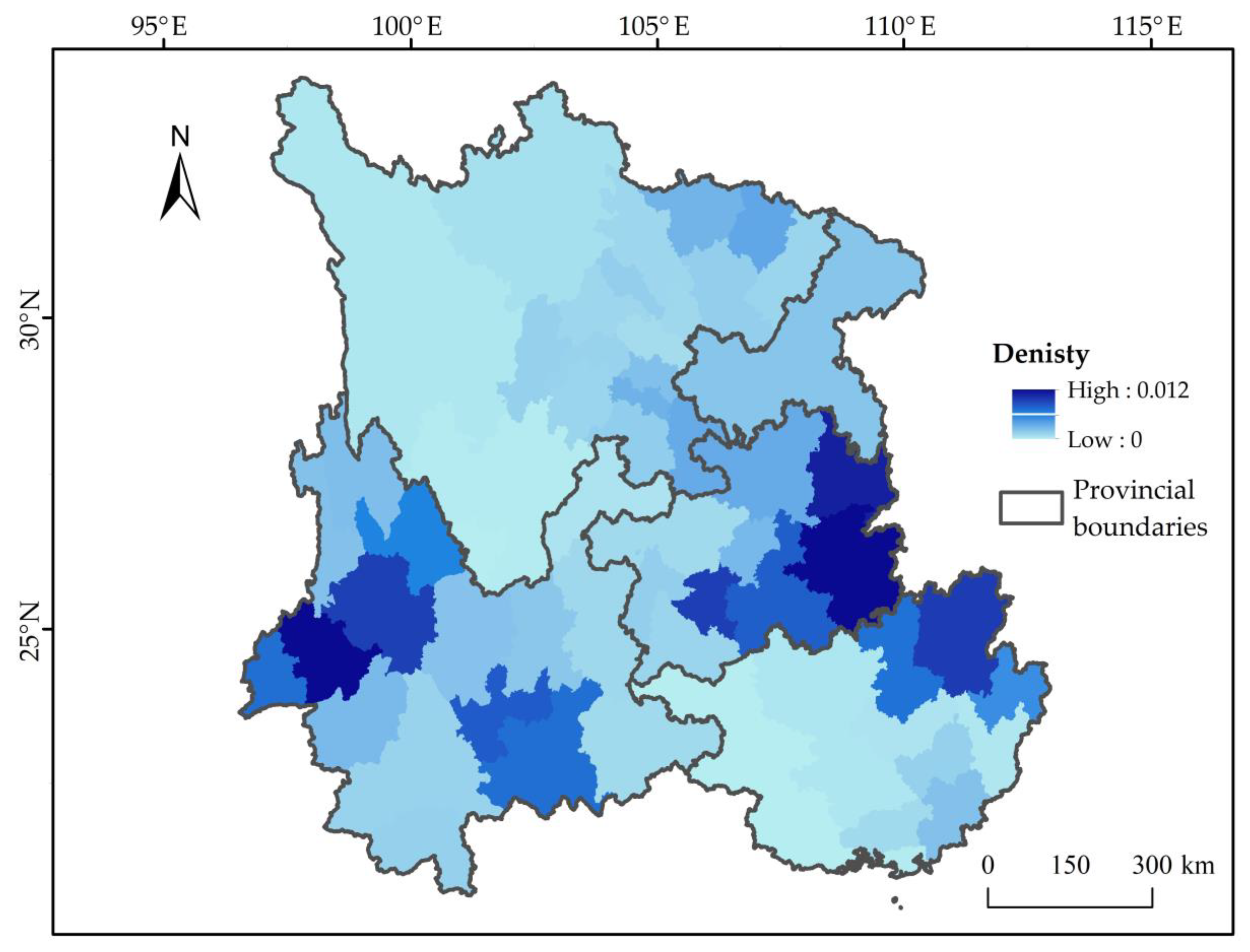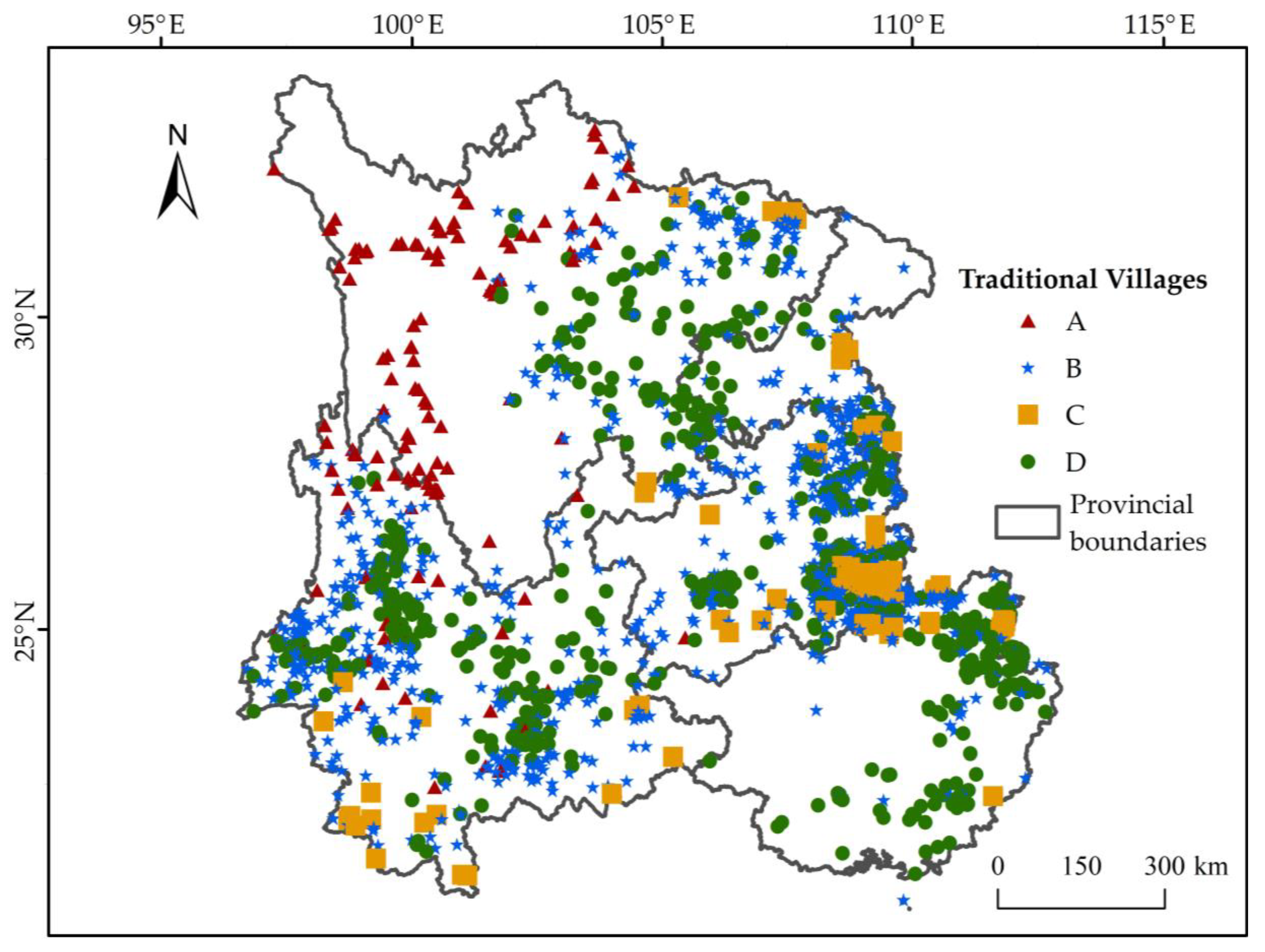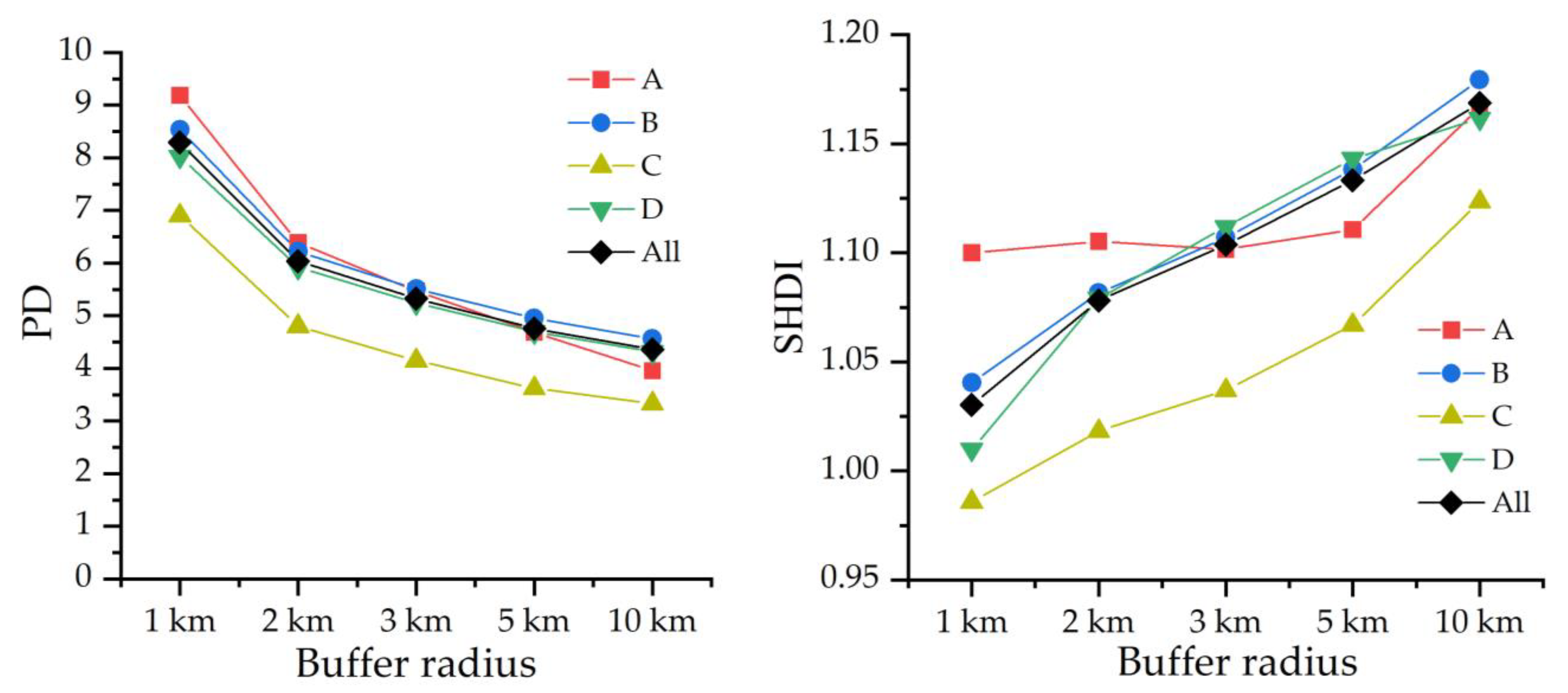Spatial Distribution and Land Use of Traditional Villages in Southwest China
Abstract
1. Introduction
2. Materials and Methods
2.1. Study Area
2.2. Data Sources
2.3. Methods
2.3.1. Spatial Pattern Analysis
2.3.2. Analysis of Geographical Characteristics
2.3.3. Cluster Analysis
2.3.4. Analysis of Land Use and Landscape Pattern
3. Results
3.1. Spatial Distribution Pattern and Geographical Features of Traditional Villages
3.2. Cluster Analysis of Traditional Villages in Southwest China
3.3. Landscape Pattern around Traditional Villages
4. Discussion
4.1. Factors Driving the Spatial Distribution of Traditional Villages
4.2. Land Use around Traditional Villages under Different Distribution Characteristics
4.3. Protection and Sustainable Development of Traditional Villages
5. Conclusions
Author Contributions
Funding
Conflicts of Interest
References
- Feng, J. The Dilemma and Development Path of Traditional Villages: Traditional Villages are Another Type of Cultural Heritage. Folk Cult. Forum 2013, 7–12. [Google Scholar] [CrossRef]
- Guidelines on Strengthening the Protection and Development of Traditional Villages. Available online: http://www.mohurd.gov.cn/wjfb/201212/t20121219_212337.html (accessed on 15 April 2021).
- Liu, Y.; Yang, R.; Li, Y. Potential of Land Consolidation of Hollowed Villages under Different Urbanization Scenarios in China. J. Geogr. Sci. 2013, 23, 503–512. [Google Scholar] [CrossRef]
- Wang, M.; Webber, M.; Finlayson, B.; Barnett, J. Rural Industries and Water Pollution in China. J. Environ. Manag. 2008, 86, 648–659. [Google Scholar] [CrossRef] [PubMed]
- Liu, Y. Introduction to Land Use and Rural Sustainability in China. Land Use Policy 2018, 74, 1–4. [Google Scholar] [CrossRef]
- China National Bureau of Statistics. Available online: http://www.stats.gov.cn/ (accessed on 15 April 2021).
- Liu, Y.; Li, Y. Revitalize the World’s Countryside. Nature 2017, 548, 275–277. [Google Scholar] [CrossRef]
- Wang, H.; Chiou, S. Research on the Sustainable Development of Traditional Dwellings. Sustainability 2019, 11, 5333. [Google Scholar] [CrossRef]
- Tao, W.; Chen, H.; Lin, J. Spatial Form and Spatial Cognition of Traditional Village in Syntactical View: A Case Study of Xiaozhou Village, Guangzhou. Acta Geogr. Sin. 2013, 68, 209–218. [Google Scholar] [CrossRef]
- Bański, J.; Wesołowska, M. Transformations in Housing Construction in Rural Areas of Poland’s Lublin Region—Influence on the Spatial Settlement Structure and Landscape Aesthetics. Landsc. Urban Plan. 2010, 94, 116–126. [Google Scholar] [CrossRef]
- Fu, J.; Zhou, J.; Deng, Y. Heritage Values of Ancient Vernacular Residences in Traditional Villages in Western Hunan, China: Spatial Patterns and Influencing Factors. Build. Environ. 2021, 188, 107473. [Google Scholar] [CrossRef]
- Xu, X.; Liu, J.; Xu, N.; Wang, W.; Yang, H. Quantitative Study on the Evolution Trend and Driving Factors of Typical Rural Spatial Morphology in Southern Jiangsu Province, China. Sustainability 2018, 10, 2392. [Google Scholar] [CrossRef]
- Lu, L.; Ling, S.; Jiao, H.; Wang, L. Landscape Features and Mechanism of Huizhou Ancient Village. Sci. Geogr. Sin. 2004, 24, 660–665. [Google Scholar] [CrossRef]
- Kang, J.; Zhang, J.; Hu, H.; Zhou, J.; Xiong, J. Analysis on the Spatial Distribution Characteristics of Chinese Traditional Villages. Prog. Geogr. 2016, 35, 839–850. [Google Scholar] [CrossRef]
- Xiong, M. Spatial Distribution and Influencing Factors of Traditional Villages in China. J. Beijing Inst. Technol. 2014, 16, 153–158. [Google Scholar] [CrossRef]
- Jin, J.; Yan, H. Analyzing the Causes of Spatial Differentiation of the Traditional Villages in Gansu Province, Western China. J. Geosci. Environ. Prot. 2020, 8, 12–25. [Google Scholar] [CrossRef]
- Fang, Y.; Liu, J. Cultural Landscape Evolution of Traditional Agricultural Villages in North China-Case of Qianzhai Village in Shandong Province. Chin. Geogr. Sci. 2008, 18, 308–315. [Google Scholar] [CrossRef]
- Wang, L.; Wen, C. Traditional Villages in Forest Areas: Exploring the Spatiotemporal Dynamics of Land Use and Landscape Patterns in Enshi Prefecture, China. Forests 2021, 12, 65. [Google Scholar] [CrossRef]
- Nowak, A.; Grunewald, K. Landscape Sustainability in Terms of Landscape Services in Rural Areas: Exemplified With A Case Study Area in Poland. Ecol. Indic. 2018, 94, 12–22. [Google Scholar] [CrossRef]
- Statuto, D.; Cillis, G.; Picuno, P. Analysis of the Effects of Agricultural Land Use Change on Rural Environment and Landscape through Historical Cartography and GIS Tools. J. Agric. Eng. 2016, 47, 28. [Google Scholar] [CrossRef]
- Ma, B.; Tian, G.; Kong, L.; Liu, X. How China’s Linked Urban–rural Construction Land Policy Impacts Rural Landscape Patterns: A Simulation Study in Tianjin, China. Landsc. Ecol. 2018, 33, 1417–1434. [Google Scholar] [CrossRef]
- Chen, Z.; Liu, Y.; Feng, W.; Li, Y.; Li, L. Study on Spatial Tropism Distribution of Rural Settlements in the Loess Hilly and Gully Region based on Natural Factors and Traffic Accessibility. J. Rural Stud. 2019. [Google Scholar] [CrossRef]
- Pickett, S.T.A.; Cadenasso, M.L. Landscape Ecology: Spatial Heterogeneity in Ecological Systems. Science 1995, 269, 331–334. [Google Scholar] [CrossRef] [PubMed]
- Liang, X.; Li, Y. Identification of Spatial Coupling between Cultivated Land Functional Transformation and Settlements in Three Gorges Reservoir Area, China. Habitat Int. 2020, 104, 102236. [Google Scholar] [CrossRef]
- Ministry of Housing and Urban-Rural Development of the People’s Republic of China. Available online: http://www.mohurd.gov.cn/ (accessed on 15 April 2021).
- Yang, R.; Xu, Q.; Long, H. Spatial Distribution Characteristics and Optimized Reconstruction Analysis of China’s Rural Settlements during the Process of Rapid Urbanization. J. Rural Stud. 2016, 47, 413–424. [Google Scholar] [CrossRef]
- Elbakidze, M.; Angelstam, P. Implementing Sustainable Forest Management in Ukraine’s Carpathian Mountains: The Role of Traditional Village Systems. For. Ecol. Manag. 2007, 249, 28–38. [Google Scholar] [CrossRef]
- Shen, Y.; Li, T.; Tang, M.; Deng, H. Spatial Patterns of Biocultural Diversity in Southwest China. Acta Ecol. Sin. 2019, 39, 2454–2461. [Google Scholar] [CrossRef]
- Shen, Y.; Mao, S.; Qiu, S.T.; Deng, H. Spatiotemporal Pattern of Cultural Diversity in Southwest China. Acta Ecol. Sin. 2018, 38, 7596–7606. [Google Scholar] [CrossRef]
- List of the First Batch of Chinese Traditional Villages. Available online: http://www.mohurd.gov.cn/wjfb/201212/t20121219_212340.html (accessed on 10 May 2021).
- List of the Second Batch of Chinese Traditional Villages. Available online: http://www.mohurd.gov.cn/wjfb/201308/t20130830_214900.html (accessed on 10 May 2021).
- List of the Third Batch of Chinese Traditional Villages. Available online: http://www.mohurd.gov.cn/wjfb/201412/t20141203_219694.html (accessed on 10 May 2021).
- List of the Fourth Batch of Chinese Traditional Villages. Available online: http://www.mohurd.gov.cn/wjfb/201612/t20161222_230060.html (accessed on 10 May 2021).
- List of the Fifth Batch of Chinese Traditional Villages. Available online: http://www.mohurd.gov.cn/wjfb/201906/t20190620_240922.html (accessed on 10 May 2021).
- Baidu Map Coordinate Picking System. Available online: https://api.map.baidu.com/lbsapi/getpoint/index.html (accessed on 10 May 2021).
- Remote Sensing and Digital Earth, Chinese Academy of Sciences. Available online: http://eds.ceode.ac.cn/sjglb/dataservice.html (accessed on 10 May 2021).
- Remote Sensing Monitoring Data of China’s Land Use in 2018. Available online: https://www.resdc.cn/data.aspx?DATAID=264 (accessed on 10 May 2021).
- Urban Data Party. Available online: https://www.udparty.com/index.php/lists/data?page=0&bk_id=279 (accessed on 10 May 2021).
- Chongqing Bureau of Statistics. Chongqing Statistical Yearbook 2016; China Statistics Press: Beijing, China, 2016; ISBN 978-7-5037-7846-9.
- Guangxi Bureau of Statistics. Guangxi Statistical Yearbook 2016; China Statistics Press: Beijing, China, 2016; ISBN 978-7-5037-7895-7.
- Guizhou Bureau of Statistics. Guizhou Statistical Yearbook 2016; China Statistics Press: Beijing, China, 2016; ISBN 978-7-5037-7896-4.
- Sichuan Bureau of Statistics. Sichuan Statistical Yearbook 2016; China Statistics Press: Beijing, China, 2016; ISBN 978-7-5037-7871-1.
- Yunnan Bureau of Statistics. Yunnan Statistical Yearbook 2016; China Statistics Press: Beijing, China, 2016; ISBN 978-7-5037-7903-9.
- Wang, Y.; He, H. Spatial Data Analysis Method, 1st ed.; Science Press: Beijing, China, 2007; ISBN 978-7-03-018966-0. [Google Scholar]
- King, T.L.; Bentley, R.J.; Thornton, L.E.; Kavanagh, A.M. Using Kernel Density Estimation to Understand the Influence of Neighbourhood Destinations on BMI. BMJ Open 2016, 6, e008878. [Google Scholar] [CrossRef]
- Li, T.; Qiu, S.; Mao, S.; Bao, R.; Deng, H. Evaluating Water Resource Accessibility in Southwest China. Water 2019, 11, 1708. [Google Scholar] [CrossRef]
- Li, F.; Ye, Y.; Song, B.; Wang, R. Evaluation of Urban Suitable Ecological Land Based on the Minimum Cumulative Resistance Model: A Case Study from Changzhou, China. Ecol. Model. 2015, 318, 194–203. [Google Scholar] [CrossRef]
- Tang, L.; Ruth, M.; He, Q.; Mirzaee, S. Comprehensive evaluation of trends in human settlements quality changes and spatial differentiation characteristics of 35 Chinese major cities. Habitat Int. 2017, 70, 81–90. [Google Scholar] [CrossRef]
- Yang, Z. Region Spatial Cluster Algorithm Based on Ward Method. China Popul. Resour. Environ. 2010, 20, 382–386. [Google Scholar]
- Xu, S.; Li, S.; Zhong, J.; Li, C. Spatial Scale Effects of the Variable Relationships between Landscape Pattern and Water Quality: Example from an Agricultural Karst River Basin, Southwestern China. Agric. Ecosyst. Environ. 2020, 300, 106999. [Google Scholar] [CrossRef]
- Jiang, G.; Zhang, F.; Chen, J.; Duan, Z.; Su, Z. Analysis of the Driving Forces of Change of Rural Residential Areas in Beijing Mountainous Areas Based on Logistic Regression Model. Trans. Chin. Soc. Agric. Eng. 2007, 23, 81–87. [Google Scholar] [CrossRef]
- Guo, X.; Ma, L.; Zhang, Q. A GIS-based Research on the Spatial Evolution Characteristics and Driving Mechanism of the Rural Settlements in Qin’an County. Econ. Geogr. 2012, 32, 56–62. [Google Scholar] [CrossRef]
- Su, S.; Xiao, R.; Jiang, Z.; Zhang, Y. Characterizing Landscape Pattern and Ecosystem Service Value Changes for Urbanization Impacts at an Eco-regional Scale. Appl. Geogr. 2012, 34, 295–305. [Google Scholar] [CrossRef]
- Long, H.; Li, T. The Coupling Characteristics and Mechanism of Farmland and Rural Housing Land Transition in China. J. Geogr. Sci. 2012, 22, 548–562. [Google Scholar] [CrossRef]
- YulitrisnaDewi, L.K. Modeling the Relationships between Tourism Sustainable Factor in the Traditional Village of Pancasari. Procedia Soc. Behav. Sci. 2014, 135, 57–63. [Google Scholar] [CrossRef]
- Lim, J.C.; Choi, B.K.; Kim, S.Y.; Eom, B.C.; Kim, J.W. Korean Traditional Village Forest (Ma-Eul-Soop) and Potential Natural Vegetation: A Case Study on the Sachon-Ri Garo-Soop in Gyeongsangbuk-do, South Korea. J. Plant Biol. 2016, 59, 515–524. [Google Scholar] [CrossRef]
- Marsden, T.; Sonnino, R. Rural development and the regional state: Denying multifunctional agriculture in the UK. J. Rural Stud. 2008, 24, 422–431. [Google Scholar] [CrossRef]




| Factor | Name | Cost | Weight |
|---|---|---|---|
| Types of road | Highway | 1 | 0.6 |
| National highway | 2 | ||
| Provincial highway | 3 | ||
| County highway | 4 | ||
| Village road | 5 | ||
| Other road | 8 | ||
| None | 30 | ||
| Land use type | Grassland, cultivated land, artificial surface | 1 | 0.2 |
| Forest, shrubs | 2 | ||
| Water | 3 | ||
| Bare land | 4 | ||
| Slope (°) | 0–3 | 1 | 0.2 |
| 3–15 | 2 | ||
| 15–25 | 3 | ||
| 25–90 | 4 |
| Metric | Level | Formula | Annotate | Description |
|---|---|---|---|---|
| Area ratio (PLAND) | Class | TA is the total patch area of all landscape elements; is the area of patch j in the ith landscape | Reflects the composition of landscape components | |
| Mean plaque area (MPS) | is the total number of patches of the ith landscape element; is the area of the jth patch in the ith landscape | Reflects the landscape scale | ||
| Patch density (PD) | Landscape | is the total number of landscape feature patches of type i; TA is the total area of all landscape feature patches | Reflects the degree of landscape fragmentation: the greater the patch density, the greater the degree of landscape fragmentation | |
| Shannon Diversity Index (SHDI) | is based on the total landscape area excluding any internal background present | Measures landscape diversity |
| Elevation (m) | Number | Percentage | Relative Position (%) | Number | Percentage |
| <500 | 499 | 23.16% | <20 | 1142 | 52.99% |
| 500~1000 | 694 | 32.20% | 20~40 | 555 | 25.75% |
| 1000~2000 | 674 | 31.28% | 40~60 | 330 | 15.31% |
| 2000~3500 | 261 | 12.11% | 60~80 | 116 | 5.38% |
| >3500 | 27 | 1.25% | >80 | 12 | 0.56% |
| Slope (°) | Number | Percentage | Nearest Water Distance (km) | Number | Percentage |
| <3 | 764 | 35.45% | <5 | 929 | 43.10% |
| 3~8 | 516 | 23.94% | 5~10 | 527 | 24.50% |
| 8~15 | 479 | 22.23% | 10~15 | 307 | 14.25% |
| 15~25 | 301 | 13.97% | 15~20 | 187 | 8.68% |
| >25 | 95 | 4.41% | >20 | 205 | 9.50% |
| Cluster | Count | Percentage (%) | Elevation (m) | Slope (°) | Relative Position (%) |
| A | 141 | 6.54 | 2816.11 a | 18.27 a | 22.46 b |
| B | 1127 | 52.30 | 1090.74 b | 10.88 b | 32.19 a |
| C | 143 | 6.64 | 655.94 d | 4.35 c | 17.45 b |
| D | 744 | 34.52 | 960.55 c | 2.83 c | 10.72 c |
| All | 2155 | 100 | 1129.83 | 8.15 | 23.17 |
| Cluster | Count | Nearest Water Distance (km) | Traffic Cost | Population (/km2) | Per GDP (×104 RMB) |
| A | 141 | 7.34 c | 0.31 a | 109.10 c | 2.69 c |
| B | 1127 | 9.51 b | 0.19 c | 174.37 b | 3.07 b |
| C | 143 | 28.19 a | 0.22 b | 209.50 b | 2.66 c |
| D | 744 | 3.75 d | 0.12 d | 685.76 a | 3.53 a |
| All | 2155 | 8.62 | 0.18 | 348.98 | 3.17 |
| Cluster | Land Use | PLAND (%) | MPS (km2) | ||||||||
|---|---|---|---|---|---|---|---|---|---|---|---|
| 1 km | 2 km | 3 km | 5 km | 10 km | 1 km | 2 km | 3 km | 5 km | 10 km | ||
| A | LU1 | 27.70 | 33.92 | 36.84 | 39.32 | 39.98 | 0.29 | 0.61 | 0.84 | 0.85 | 0.81 |
| LU2 | 22.27 | 23.02 | 22.97 | 23.13 | 22.57 | 0.19 | 0.29 | 0.28 | 0.30 | 0.27 | |
| LU3 | 22.78 | 22.57 | 22.86 | 22.99 | 22.89 | 0.20 | 0.31 | 0.55 | 0.92 | 0.81 | |
| LU4 | 24.83 | 19.46 | 17.21 | 14.98 | 12.83 | 0.24 | 0.38 | 0.34 | 0.49 | 0.27 | |
| LU5 | 1.70 | 1.17 | 0.92 | 0.82 | 0.84 | 0.03 | 0.05 | 0.05 | 0.12 | 0.13 | |
| LU6 | 2.39 | 1.53 | 1.05 | 0.66 | 0.47 | 0.05 | 0.12 | 0.13 | 0.13 | 0.12 | |
| LU7 | 1.24 | 0.97 | 0.81 | 0.91 | 2.07 | 0.02 | 0.02 | 0.02 | 0.04 | 0.12 | |
| D | LU1 | 34.30 | 39.31 | 41.80 | 44.64 | 46.72 | 0.47 | 0.93 | 1.14 | 1.16 | 1.05 |
| LU2 | 17.96 | 19.03 | 19.63 | 19.76 | 19.84 | 0.23 | 0.42 | 0.45 | 0.48 | 0.47 | |
| LU3 | 11.50 | 11.31 | 11.15 | 11.05 | 11.22 | 0.08 | 0.09 | 0.09 | 0.09 | 0.11 | |
| LU4 | 30.25 | 26.05 | 23.76 | 21.56 | 19.68 | 0.33 | 0.42 | 0.46 | 0.47 | 0.38 | |
| LU5 | 1.33 | 1.13 | 1.13 | 1.12 | 1.00 | 0.03 | 0.07 | 0.13 | 0.26 | 0.21 | |
| LU6 | 3.94 | 2.52 | 1.99 | 1.54 | 1.30 | 0.05 | 0.05 | 0.05 | 0.05 | 0.06 | |
| LU7 | 0.65 | 0.73 | 0.71 | 0.69 | 0.74 | 0.01 | 0.02 | 0.02 | 0.03 | 0.04 | |
| C | LU1 | 31.11 | 36.10 | 39.71 | 43.25 | 46.33 | 0.46 | 1.07 | 1.18 | 1.25 | 1.16 |
| LU2 | 24.70 | 27.25 | 27.69 | 27.78 | 27.59 | 0.45 | 1.22 | 1.72 | 1.58 | 1.40 | |
| LU3 | 7.99 | 8.07 | 8.14 | 8.08 | 8.42 | 0.05 | 0.07 | 0.08 | 0.08 | 0.08 | |
| LU4 | 27.54 | 21.22 | 18.28 | 15.69 | 14.50 | 0.33 | 0.41 | 0.38 | 0.31 | 0.23 | |
| LU5 | 1.03 | 0.82 | 0.78 | 0.64 | 0.62 | 0.02 | 0.04 | 0.07 | 0.12 | 0.14 | |
| LU6 | 4.07 | 2.36 | 1.77 | 1.29 | 1.01 | 0.05 | 0.05 | 0.05 | 0.05 | 0.06 | |
| LU7 | 0.72 | 0.44 | 0.47 | 0.57 | 0.62 | 0.01 | 0.01 | 0.02 | 0.05 | 0.05 | |
| D | LU1 | 24.68 | 30.00 | 32.82 | 36.41 | 41.17 | 0.28 | 0.55 | 0.73 | 0.89 | 0.97 |
| LU2 | 14.22 | 15.43 | 16.18 | 16.90 | 17.30 | 0.18 | 0.32 | 0.36 | 0.35 | 0.35 | |
| LU3 | 9.16 | 9.47 | 9.55 | 9.30 | 8.94 | 0.05 | 0.07 | 0.07 | 0.07 | 0.07 | |
| LU4 | 40.15 | 36.33 | 33.86 | 30.67 | 26.73 | 0.56 | 0.96 | 1.07 | 0.86 | 0.67 | |
| LU5 | 2.65 | 2.36 | 2.18 | 1.98 | 1.67 | 0.06 | 0.12 | 0.17 | 0.24 | 0.25 | |
| LU6 | 8.32 | 5.62 | 4.41 | 3.41 | 2.56 | 0.10 | 0.10 | 0.09 | 0.08 | 0.08 | |
| LU7 | 0.58 | 0.57 | 0.53 | 0.49 | 0.52 | 0.01 | 0.01 | 0.02 | 0.02 | 0.03 | |
Publisher’s Note: MDPI stays neutral with regard to jurisdictional claims in published maps and institutional affiliations. |
© 2021 by the authors. Licensee MDPI, Basel, Switzerland. This article is an open access article distributed under the terms and conditions of the Creative Commons Attribution (CC BY) license (https://creativecommons.org/licenses/by/4.0/).
Share and Cite
Zheng, X.; Wu, J.; Deng, H. Spatial Distribution and Land Use of Traditional Villages in Southwest China. Sustainability 2021, 13, 6326. https://doi.org/10.3390/su13116326
Zheng X, Wu J, Deng H. Spatial Distribution and Land Use of Traditional Villages in Southwest China. Sustainability. 2021; 13(11):6326. https://doi.org/10.3390/su13116326
Chicago/Turabian StyleZheng, Xiye, Jiahui Wu, and Hongbing Deng. 2021. "Spatial Distribution and Land Use of Traditional Villages in Southwest China" Sustainability 13, no. 11: 6326. https://doi.org/10.3390/su13116326
APA StyleZheng, X., Wu, J., & Deng, H. (2021). Spatial Distribution and Land Use of Traditional Villages in Southwest China. Sustainability, 13(11), 6326. https://doi.org/10.3390/su13116326






